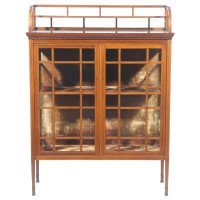Waring and Gillows. A chequer, ebony and boxwood inlaid walnut sideboard in the manner of M H Baillie Scott
POA
Waring and Gillow. A chequer, ebony and boxwood inlaid walnut sideboard, in the manner of M.H. Ballie, labelled, 188cm high, 202cm wide, 71cm deep Under close inspection of the label it says 'Waring and Gillow', the 'Gillow' being so small one can only see it under an eye glass. During the final years of the 19th century Gillows ran into financial difficulty and from 1897 began a loose financial arrangement with Waring of Liverpool. Gillows and Warings both had stores in Oxford Street, London and it is also thought that the expiry of the former's lease also prompted the two firms joining together. This was legally ratified by the establishment of Waring and Gillow in 1903. Gillow of Lancaster absorbed, arguably, the most exceptional makers of the late Victorian period Collinson and Lock. They had been the makers of important furniture to the designs of Edward William Godwin, the godfather of the Modern Movement. Therefore the Gillow, Waring and Collinson and Lock, each a prominent firm, came together to form what, turned out to be, one of the top furniture companies in the land drawing on over 160 years of experience from Gillows alone. It remained an independent firm until 1985 when it was taken over. This sideboard is a historic work of art made at the very beginnings of the famous Waring and Gillow, known around the globe for innovation, exceptional quality and cutting edge design from the Arts and Crafts Movement.










